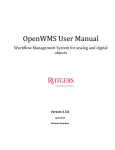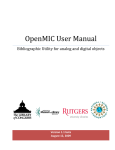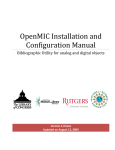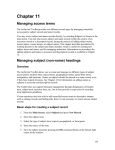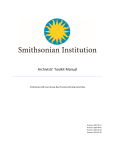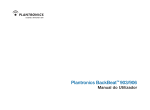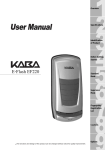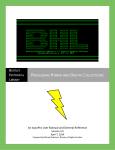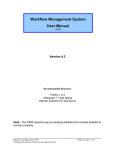Download OpenMIC User Manual
Transcript
RUTGERS UNIVERSITY LIBRARIES OpenMIC User Manual Bibliographic Utility for analog and digital objects Kalaivani Ananthan Version 2.0 October 2008 Funded by the Library of Congress Table of Contents I. Introduction II. Using this Manual Section 1: Workflow in OpenMIC Section 2: Object Hierarchy in OpenMIC Section 3: Object types in OpenMIC Section 4: Using OpenMIC Step 1: Administration ……………..……..……………………………………….…………. 1.1) 1.2) 1.3) Organization Management …………………………………. Collection Management ……………………………………… User Management ……………………………………………… Step 2: Metadata Management…………… ………………………………………………… 2.1) Create Metadata manually ……………………………………… 2.1.1) Create Template ………………………………………. 2.1.2) Create multiple instances of metadata ……… 2.2) Batch load existing metadata …………………………….. Step 3: Export (Optional) ……………………………………………………………………….. Section 5: Other Administrative Functions 1) 2) 3) 4) Controlled Vocabularies ………………………………………….. Database Cleanup ………………………………………………… Transaction Management (Not implemented in this release) Announcements (Not implemented in this release) Page 2 of 52 I. Introduction OpenMIC is an open source, web‐based bibliographic utility that can be used as a standalone application or integrated with other repository architectures by a wide range of organizations. It provides a complete metadata creation system for analog and digital materials, with services to export these metadata in standard formats. The bibliographic utility features a METS data architecture which can be used in any METS‐based or METS‐compliant environment. It uses MODS as an underlying metadata schema for descriptive MD, NISO/AES standard for technical MD and PREMIS for source MD and rights MD. It outputs an XML wrapper for the METS components as a single object. The bibliographic utility data model is primarily an event‐based data model, intended to document what happens to a resource at a specific time and place. Preservation and condition events, provenance events, rights events, and descriptive events document what happens to a resource throughout its lifecycle. Details of the events can include associated entities (such as an exhibit curator) and associated objects (such as an exhibit catalog). OpenMIC is a core application for the Moving Image Collections (MIC) initiative developed at the Rutgers University Libraries with funding from the Library of Congress. II. Using this Manual This manual assumes that the software has already been installed and configured. For installing the software, please see the OpenMIC installation and configuration manual. This manual describes how to use OpenMIC to create and maintain metadata for analog and digital objects such as photographs, moving images etc. There are five sections in this manual. Section 1 provides a typical workflow diagram for digital objects in OpenMIC. Section 2 provides a diagram showing the hierarchy of objects in OpenMIC. Section3 explains the different types of objects in OpenMIC. Section 4 provides detailed step‐by‐step instructions to create or maintain digital objects. Section 5 provides detailed step‐by‐step instructions to perform other administrative tasks. Page 3 of 52 Section 1: Workflow in OpenMIC Page 4 of 52 Section 2: Object Hierarchy in OpenMIC Section 3: Object Types in OpenMIC 1. Collection Object A collection object is a special object that contains the information about the organization that holds the collection and the description of the collection. 2. Resource Object A resource object is an item that contains information about the resource that is being digitized. Page 5 of 52 Section 4: Using OpenMIC Note 1: Recommended Browsers – Firefox 1.0; Netscape 7.1 and above; IE5.0 and above Note 2: Disable pop‐up blocking Note 3: Enable Cookies OpenMIC is used to create and maintain metadata for analog and digital materials. The software can be used as a standalone system or can be integrated with other repositories. There are three basic steps to create metadata. Step 1: Administration Before you start creating metadata, you must create an organization record and at least one collection record. Please note that there should be only one organization record for each organization. You may create as many collections you need for each organization. 1.1) Organization Management Create Organization: i. ii. iii. iv. v. vi. vii. Page 6 of 52 Login as Super User. Select Digital Workflow Management System from the main screen. Select Administration. Select Organization Management. Select Create New Organization. Enter Marc Org ID, Organization Name, address, and contact information. Click Save. Figure 1.1.1: Main Screen Figure 1.1.2: MIC Catalog Main screen Page 7 of 52 Figure 1.1.3: Administration Screen Figure 1.1.4: Organization List Screen Page 8 of 52 Figure 1.1.5: Create Organization Screen Edit Organization: i. ii. iii. iv. v. vi. vii. Page 9 of 52 Login as Super User. Select Digital Workflow Management System from the main screen. Select Administration. Select Organization Management. Select Organization. Click Edit. Edit metadata and click Save. Figure 1.1.6: Organization List Screen Figure 1.1.7: Edit Organization Screen Page 10 of 52 Delete Organization: Note: Deleting Organization will delete all the collections and resources belong to this organization. i. ii. iii. iv. v. vi. Login as Super User. Select Digital Workflow Management System from the main screen. Select Administration. Select Organization Management. Select Organization. Click Delete. Application Review: This feature is not fully implemented in this version. Figure 1.1.8: Organization List Screen Page 11 of 52 1.2) Collection Management You may create as many collection objects you need for each organization. A collection object is a special object that contains the information about the organization that holds the collection and the description of the collection. It keeps all the resources that belong to a collection together for search and display. Create Collection i. ii. iii. iv. v. vi. vii. viii. Select Digital Workflow Management System from the main screen. Select Administration. Select Collection Management. Select Organization. Click Show Collection List. Click Create New Collection. Enter metadata for the collection. Click Save. Figure 1.2.1: Main Screen Page 12 of 52 Figure 1.2.2: MIC Catalog Main Screen Figure 1.2.3: Administration Screen Page 13 of 52 Figure 1.2.4: Organization List Screen Figure 1.2.5: Collection List Screen Page 14 of 52 Figure 1.2.4: Metadata Entry Screen Edit Collection i. ii. iii. iv. v. vi. vii. viii. Select Digital Workflow Management System from the main screen. Select Administration. Select Collection Management. Select Organization. Click Show Collection List. Select Collection. Click Edit. Edit metadata and click Save. Page 15 of 52 Figure 1.2.6: Administration Screen Figure 1.2.7: Organization List Screen Page 16 of 52 Figure 1.2.8: Collection List Screen Delete Collection Note: Deleting collection will delete all the resources belong to the collection. i. ii. iii. iv. v. vi. vii. Select Digital Workflow Management System from the main screen. Select Administration. Select Collection Management. Select Organization. Click Show Collection List. Select Collection. Click Delete. Page 17 of 52 Figure 1.2.9: Administration Screen Figure 1.2.10: Organization List Screen Page 18 of 52 Figure 1.2.11: Collection List Screen View Collection There are three options available to view a collection record: METS, FOXML (Fedora Object XML for Fedora repositories), and TEXT. i. ii. Select the collection you want to view from the collection list. Click METS, FOXML, or TEXT. Page 19 of 52 Figure 1.2.12: Collection Record in METS Page 20 of 52 Figure 1.2.13: Collection Record in FOXML for Fedora Repositories Page 21 of 52 Figure 1.2.14: Collection Record in TEXT Page 22 of 52 1.3) User Management It is strongly recommended to create individual user accounts to be able to keep track of the work performed by the users. The user information such as user name and email is written in the xml. Each user account is associated with role(s). Create User i. ii. Select Manage User Account from the main screen Enter First Name, Last Name, Address (optional), Email, UserID, password. Retype password. Click Submit. Next you need to assign role to this user. If there are no role(s) created for your organization, create role(s) before you proceed. Select the user. Click Assign roles. Select the appropriate role for this user. Click Submit. iii. iv. v. vi. vii. viii. ix. Create Role i. ii. iii. iv. v. vi. Select Organization from the pull down list. Select WMS Utility from the pull down list for module. Click edit roles. Enter role name and role description in the data entry box on Role‐ Privilege Relationship screen. Select privilege(s) associated with this role. See Table 1. for associated permissions for each role. Click Submit. Page 23 of 52 Privileges User Organization Super User Create user; Edit user; Delete user; Create roles; Edit roles; Delete roles Create organization; Edit organization; Delete organization Manage User Edit username Edit password Manage Collections Edit username Edit password Edit organization Configure Cataloging Utility Edit username Edit password Mapping Edit username Edit password Create collection; Edit collection; Delete collection; View collection Setup required elements; Create collection level template; Edit collection level template; Delete collection level template; View collection level template Create or revise metadata mapping; Upload sample records; Check map Batch Import Edit username Edit password Export Edit username Edit password Edit username Edit password Not implemented Not implemented Not implemented Not implemented Batch export of metadata records Create personal template; Edit personal template; Delete personal template; Create metadata record; Edit metadata records; Delete metadata record; View metadata record Not implemented Not implemented Not implemented Not implemented Metadata Cataloging View/Generate Reports Read Only Table 1: User Privileges and Permissions Page 24 of 52 Permissions Collection Metadata Create or revise metadata mapping; Upload sample records; Check map; Batch import of metadata records; Create collection; Edit Batch export of metadata collection; Delete collection; records; Create personal View collection; Setup template; Edit personal required elements; Create template; Delete personal collection level template; template; Create metadata Edit collection level template; record; Edit metadata Delete collection level records; Delete metadata template; View collection record; View metadata level template record; Batch import of metadata records Figure 1.3.1: Main Screen Page 25 of 52 Figure 1.3.2: Create User Account Screen Figure 1.3.3: Registered Users Screen Figure 1.3.4: Assign Role Screen Page 26 of 52 Figure 1.3.5: Role – Privilege Relationship Screen Edit User i. ii. iii. Select Manage User Account from the main screen. Select user from the Registered Users screen. Edit user information and click Submit. Edit Role i. ii. iii. iv. v. Page 27 of 52 If you are editing the role, click Assign Role. Select Organization from the pick list. Select Module. Select Role from the pick list. Click Submit. Figure 1.3.6: Edit User Screen Figure 1.3.6: Registered User Screen Page 28 of 52 Delete User i. ii. iii. Select Manage User Account from the main screen. Select user from the Registered Users screen. Click Delete User. Delete Role (not implemented in the current version) Figure 1.3.7: Registered User Screen Step 2: Metadata Management You must complete Step 1 prior before you are able to create metadata. There are two ways to create metadata in OpenMIC. 1) Create metadata manually. This option allows users to create one metadata record at a time. 2) Batch import. This option allows users to batch load metadata from an existing database. Page 29 of 52 2.1) Create Metadata Manually i. ii. iii. iv. v. vi. vii. viii. Tips: 1. In some cases, all or many of the resources in a collection will share same metadata. Some technical metadata and rights metadata might be identical. The template utility allows collection managers and metadata creators to create generic records that contain default data. When a template is enabled, this default data is added to the metadata record automatically when Create Metadata is selected. 2. Templates can be enabled at the collection level or at resource level. To enable a template at resource level, click on Template, select template from the template list and click Apply. Refer to 2.1.1 to create template. Page 30 of 52 Select Manage MIC Union Catalog. Select Metadata and digital object. Select Collection from the collection list. Select Metadata Cataloging from the welcome screen. Select Start Cataloging. Click Create Metadata. Enter metadata. For information about the metadata elements, please refer to Metadata Guides found on the download page. Click Save. Metadata Screen Navigation Help CLEAR ALL Clear all data values in the record. VIEW ENTRIES View metadata in plain text. EXIT TEMPLATE Exit without saving data values. SAVE Enable collection level template or personal template when creating metadata record. Save all data values and exit. Tab to Toggle between Descriptive MD, Source MD, Technical MD, and Rights MD. View/Edit source‐technical MD relationship Establish relationship between source and technical metadata when creating multiple instances of source and technical metadata for a resource object. Page 31 of 52 Metadata for item 1 Enter multiple descriptive metadata for a resource object. Display Option: REQUIRED elements only Display required metadata elements only Display Option: All Elements NAVIGATOR Display all metadata elements. Jump to an element on this page. Use mouse scroll wheel to move up and down the list. Figure 2.1.1: Main Screen Figure 2.1.2: MIC Catalog Main Screen Page 32 of 52 Figure 2.1.3: Collection List Screen Figure 2.1.4: Cataloging Screen Page 33 of 52 Figure 2.1.5: Start Cataloging Screen Figure 2.1.6: Metadata Record List Screen Page 34 of 52 Figure 2.1.7: Descriptive Metadata Entry Screen 2.1.1) Create Template There are two levels of template available in the OpenMIC ‐‐ collection level and personal level. To create a collection level template, the user must have “Configure Cataloging Utility” permission. A collection level template can be applied to all resources within the collection by metadata creators who have access to the collection. If the collection level template is set as a default template, it is applied to metadata record automatically when Create Metadata is selected. If it is not set as a default template, metadata creators can enable the template at the time they create metadata record. A personal level template is created by metadata creator. Templates created at this level are available only to the owner of the template. If a personal level template is set as a default template, it is applied to metadata record automatically when Create Metadata is selected. If it is not set as a default template, metadata creators can enable the template at the time they create metadata record. Follow the steps below to create collection level template: i. ii. iii. Page 35 of 52 Select Metadata and digital objects from the MIC Catalog screen. Select Customize system settings for this collection Select Template. iv. v. vi. vii. viii. ix. x. xi. xii. Select Create New Template. You will get a screen similar to Create Metadata screen. Enter data values that will be shared by all the resources in this collection. Click Save. If you want to save an existing metadata record as a template, select Use Existing Metadata. Select the record to use as template. Click Apply to Template. All the data values from the selected metadata record will be auto populated in the record. Enter main title for this template. Click Save. If you want to save this template as a default template, click Set Default button. Figure 2.1.1.1: OpenMIC Main Screen Page 36 of 52 Figure 2.1.1.2: Main Cataloging Screen Figure 2.1.1.3: Template list screen Page 37 of 52 Figure 2.1.1.4: Template data entry screen Figure 2.1.1.5: Existing metadata record screen Page 38 of 52 Follow the steps below to create personal template: i. ii. iii. iv. v. vi. vii. viii. ix. x. xi. xii. Select Metadata and digital objects from the MIC Catalog screen. Select Metadata Cataloging. Select Setup Personal Template. Select Create New Template. You will get a screen similar to Create Metadata screen. Enter data values that will be shared by all the resources in this collection. Click Save. If you want to save an existing metadata record as a template, select Use Existing Metadata. Select the record to use as template. Click Apply to Template. All the data values from the selected metadata record will be auto populated in the record. Enter main title for this template. Click Save. If you want to save this template as a default template, click Set Default button. Figure 2.1.1.6: OpenMIC main screen Page 39 of 52 Figure 2.1.1.6: Main Cataloging Screen Figure 2.1.1.7: Cataloging Screen Page 40 of 52 Figure 2.1.1.8: Template list screen Figure 2.1.1.4: Template data entry screen Page 41 of 52 Figure 2.1.1.5: Existing metadata record screen 2.1.2) Create Multiple instances of metadata 2.2) Batch load existing metadata Metadata from existing database(s) can be batch loaded into OpenMIC. The OpenMIC has built‐in MARCXML and MODS XML mapping tools which allow the metadata creators to automatically maps metadata into the OpenMIC database. If metadata is in any other format, you need to map your data elements to OpenMIC database using the Mapping Utility. Follow steps below to batch load metadata from existing database(s). Step 1: Mapping Data elements i. ii. iii. Select Metadata and Digital objects from the OpenMIC Main Screen. Select Mapping Utility. Select Simple MIC Display to map MIC elements or Full METS/MODS to map your metadata elements. Page 42 of 52 iv. v. vi. vii. viii. ix. x. xi. xii. xiii. xiv. xv. xvi. xvii. xviii. xix. xx. xxi. xxii. xxiii. xxiv. xxv. xxvi. Select Create or Revise Mapping. If you have selected, Simple MIC Display option in step iii, you will get MIC Mapping Template Screen (figure 2.2.1.2). Follow the screen instructions to map your metadata elements. If you have selected, Full METS/MODS option, you will get a screen to enter a map name and to select schema of your records (figure 2.2.1.3). Enter name and select schema. Click save. If you have selected MARC (xml) or MODS (xml), mapping is automatically provided by OpenMIC. Proceed to step 2. If you have selected In‐house (text), you must map metadata elements from the in‐house database to the OpenMIC database. You also need to export the metadata in .txt. Enter the name of the elements in the same order as it appears from the in‐house database. If there are more than 10 elements in the database, click More fields. Use edit tools “<<” and “X” to insert or remove data elements from the list. Enter the field delimiter used to create your text file. Click Update Fields. You will get a screen to map the in‐house data elements to the OpenMIC database. Select the element on the left side of the window from the in‐house database and select the appropriate OpenMIC database element. This will automatically map these two elements and these elements will appear in the mapping list. To edit mapping, click on the radio button. If the data elements have multiple values, enter the value separator in the “Multi‐value Separator” box in the mapping results window. When you are done with mapping, click Save. Now you can upload the text file to check mapping before starting the batch import. Select the sample file from the pull down list. Browse and Upload a sample text file. It is recommended to prepare a sample file to test mapping. Click Submit. Select Check Map from the Mapping Screen. Sample records will be displayed on the screen. Select a record and click on TEXT or XML (METS) to view the mapping. Review uploaded records. If you are satisfied with the mapping results, proceed with batch import. Page 43 of 52 Figure 2.2.1.1: Mapping Screen Figure 2.2.1.2: Simple MIC Mapping Template screen Page 44 of 52 Figure 2.2.1.3: MIC Mapping Screen Page 45 of 52 Figure 2.2.1.4: Mapping Field List Screen 1 Page 46 of 52 Figure 2.2.1.5: Mapping Field List Screen 2 Page 47 of 52 Figure 2.2.1.6: Upload Text File Screen Figure 2.2.1.7: Review Sample Records Screen Page 48 of 52 Step 2: Batch Import i. ii. iii. iv. v. vi. vii. viii. ix. x. xi. xii. xiii. xiv. xv. xvi. Select Batch Import from the Main cataloging Screen. Select Metadata Schema. Select Record Format (XML for MARC and MODS; TXT (tab‐delimited) for in‐house (text). Select Mapping Name. Select “Yes” if the file has already been uploaded, otherwise, select “No”. Select Show Step2. If you have selected “Yes”, select an uploaded file to import from the pull down. If you have selected “No”, you will be prompted to select the location of the file. Select “Local Computer” if the file is on the PC; otherwise, select “Server”. Click Show Step 2. If you have selected “Local Computer”, browse and select the file. Click Upload/Import. If you have selected “Server”, enter the absolute path of the file. Click Upload/Import. Click Refresh check the status of the import. Once the import is completed, you will be able to review the records in the metadata record list. Figure 2.2.1.8: Metadata Import Selection Screen Page 49 of 52 Figure 2.2.1.9: Metadata Import File Upload/import Screen 1 Figure 2.2.1.10: Metadata File Upload /import Screen Screen 2 Page 50 of 52 Step 3: Export (Optional) There are two possible scenarios when you may want to export records: 1) Organization using a repository may export the bibliographic records in the OpenMIC database as METS and convert to your repositories native schema using third‐party tools or XSLT transformations provided by you. 2) Organization with no repository may export a copy of the bibliographic records in the OpenMIC database as METS and made available to an XML search and retrieval facility, such as Lucene or Zebra. Note: Organization with Fedora repository may use OpenMIC to manage metadata. You need to add the file section in the xml before ingesting into fedora repository or wait until OpenWMS is ready for download. Follow steps below to export records: i. ii. iii. iv. v. vi. Select Export from the Main Cataloging Screen. Select Export Format (METS). Select Export Destination (File). File export option will automatically be set to “one record per file”. Select File Name Prefix. Specify record(s) to export. o There are three options available. “All records of this collection” will export every record in the collection in a separate file under the export directory configured by the system administrator. o If “A subset of this collection “is selected, a pop‐up box will be prompted to select a range to export. o If “Single record” is selected, a pop‐up box will be prompted to select a record to export. vii. viii. Click Export. Click Refresh to monitor the progress of export. Page 51 of 52 Figure 3.1: Export Screen Page 52 of 52




















































